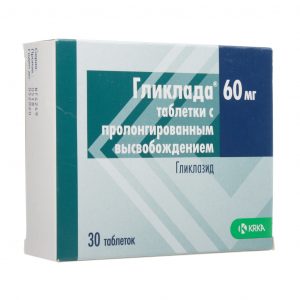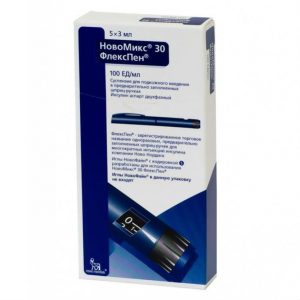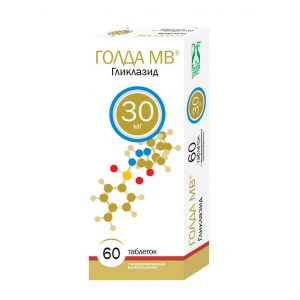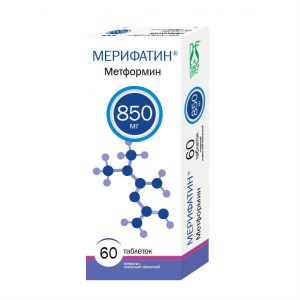Description
Pharmacological action
Gozogliptin is an active, highly selective inhibitor of the enzyme dipeptidyl peptidase-4 (DPP-4), designed to treat type 2 diabetes mellitus. By inhibiting the activity of DPP-4, gozogliptin increases the concentration of the hormones of the incretin family of synthesized in the intestine: glucagon-like peptide-1 (GLP-1) and glucose-dependent insulinotropic polypeptide (HIP). An increase in the concentration of GLP-1 and HIP causes an increase in the sensitivity of pancreatic beta cells to glucose, which leads to an increase in the synthesis and secretion of insulin. An increase in GLP-1 concentration causes an increase in the sensitivity of pancreatic alpha cells to glucose, which leads to an improvement in glucose-dependent regulation of glucagon secretion. Reducing increased secretion of glucagon during meals causes a decrease in insulin resistance. A decrease in glucagon concentration against the background of an increase in insulin concentration, due to an increase in the concentration of GLP-1 and HIP, causes a decrease in glucose production by the liver, which leads to a decrease in blood glucose. In patients with type 2 diabetes mellitus with hyperglycemia, these changes in the secretion of insulin and glucagon lead to a decrease in the concentration of glycated hemoglobin HbA1c and a decrease in the concentration of glucose in blood plasma both on an empty stomach and after eating. When using gozogliptin in more than 750 patients with type 2 diabetes mellitus for 12 to 36 weeks as a monotherapy or in combination with metformin, a significant long-term decrease in the concentration of HbA1c, fasting blood glucose and 2 hours after eating was observed. During treatment with gozogliptin, there was no significant change in body weight the incidence of hypoglycemia was minimal.
Indications
Type 2 diabetes mellitus (in combination with diet therapy and exercise):
· as monotherapy in case of ineffective diet therapy and exercise in patients with contraindication to the use of metformin
· in combination with metformin as starting therapy, or when diet and physical activity in combination with monotherapy with one of the listed drugs do not lead to adequate glycemic control.
Contraindications
– Hypersensitivity to gosogliptin or any component of the drug.
– Type 1 diabetes.
– Diabetic ketoacidosis.
– Severe impairment of liver function.
– Chronic severe renal failure.
– Children under 18 years of age (efficacy and safety of use not established).
– Pregnancy, the period of breastfeeding.
Caution
Patients with a history of pancreatitis. It is recommended to use Sarerex ® with caution in patients with moderate chronic renal failure.
Special instructions
The use of Sarerex ® in patients with type 1 diabetes mellitus or for the treatment of diabetic ketoacidosis is contraindicated.
In patients with mild chronic renal failure, a dose reduction is not required. Due to the possibility of increasing the concentration of gosogliptin in blood plasma in patients with moderate renal failure, it is recommended that the drug be used with caution in these patients. It is not recommended to use the drug in patients with severe renal failure due to the limited experience with this group of patients. The drug is not recommended for use in patients with severe hepatic impairment (ALT or AST> 2, 5 times higher than VGN) due to limited experience with the drug in this category of patients.
Composition
Active ingredient: gozogliptin malate 40.986 mg (in terms of gozogliptin 30 mg).
Excipients: microcrystalline cellulose, 260.676 mg, calcium hydrogen phosphate, 130.338 mg, sodium carboxymethyl starch, 13.500 mg, magnesium stearate, 4,500 mg, polyvinyl alcohol, 7,200 mg, titanium dioxide, 4,500 mg, macrogol 4000, 3,636,664 mg, tal .
Dosage and administration of
Sarerex ® is taken orally once a day in the morning or in the evening, regardless of food intake. Tablets should be swallowed whole without chewing, washed down with water.
The dosage regimen of the drug should be selected individually depending on the effectiveness and tolerability. The recommended initial dose of the drug during monotherapy or as part of a two-component combination therapy with metformin is 20 mg per day. In the absence of achieving the target glucose concentration in the blood, the dose of the drug can be increased to 30 mg per day. If the goals of glycemic control are not achieved with the maximum recommended daily dose of 30 mg, the additional use of metformin is recommended. The dosage regimen of metformin should be selected based on the recommended doses for metformin. If you miss a dose of Sarerex ®, the usual dose should be taken as soon as possible after the discovery of the fact of missing. Inadmissible reception of a double dose of the drug Satereks ®
Elderly
No dose adjustment is required in elderly patients.
Use in cases of impaired liver function
Since experience with gozogliptin in patients with severely impaired liver function is limited, the drug is not recommended for use with an increase in ALT or AST> 2.5 times above the upper limit of normal (VNI).
Use in cases of impaired renal function
In patients with mild chronic renal failure, dose adjustment is not required. In patients with moderate chronic renal failure, it is recommended to limit the daily dose to 20 mg. Sarerex ® is not recommended for use in patients with severe chronic renal failure due to the limited experience with this group of patients.
Side effects of
When using Sarerex ® as a monotherapy or in combination with metformin, most adverse events (AEs) were mild, temporary, and did not require discontinuation of therapy. No correlation was found between the incidence of AE and age, gender, ethnicity, duration of use, or dosing regimen.
The following criteria were used to assess the incidence of AEs: very often ( 1/10) often ( 1/100, <1/10), infrequently ( 1/1000, <1/100), rarely ( 1/10000, <1/1000), very rarely, including individual messages ( 1/10000). When using gosogliptin in doses of 20 mg and 30 mg once a day, the frequency of discontinuation of therapy due to the development of AE was 1.3%. According to the results of clinical trials, the frequency of episodes of symptomatic hypoglycemia in patients receiving gosogliptin did not exceed 1% and, as a rule, was associated with eating disorders and increased physical activity. In the use of gozogliptin, there were no cases of severe hypoglycemia. When using Saterex ® at a dose of 20 mg and 30 mg once a day as a monotherapy On the background of gozogliptin monotherapy, associated or possibly related AEs were observed in 2.7% of patients. No severe AEs have been reported during clinical trials. The following AEs were observed: Immune system disorders: infrequently allergic dermatitis. Disorders of the nervous system: infrequently – dizziness, headache, drowsiness. Disorders of the gastrointestinal tract: infrequently – constipation. Disorders from the liver and biliary tract: infrequently – increased activity of “liver” enzymes (ALT, AST). General disorders and disorders at the injection site: infrequently – asthenia, a feeling of fatigue. With a combination of Saterex ® at a dose of 20 mg and 30 mg once a day with metformin On the background of combination therapy with metformin with unmodified release (1000-2000 mg / day), associated or possibly related to taking the drug were observed in 3.3 % of patients. The following AEs were observed: Disorders of the nervous system: infrequently – headache. Disorders of the gastrointestinal tract: infrequently – diarrhea, dyspepsia, pancreatitis. Disorders from the liver and gallbladder: infrequently – cholecystitis, steatosis, increased activity of “liver” enzymes (ALT, AST), increased bilirubin, polyp of the gallbladder. Disorders of the kidneys and urinary tract: infrequently – urinary tract infections. General disorders and disorders at the injection site: infrequently – peripheral edema, back pain. Overdose of Clinical studies of the Saterex ® drug in healthy volunteers have shown that gosogliptin is well tolerated in doses up to 300 mg. Dose studies over 300 mg have not been conducted. With a single use of the drug at a dose of 300 mg, dizziness, muscle pain, and dry mouth can be observed. All symptoms of an overdose and changes in laboratory parameters disappear after discontinuation of the drug. In case of an overdose, it is necessary to carry out generally accepted measures: gastric lavage, monitoring of vital signs, symptomatic therapy, if necessary. It is possible to remove the drug from the body using 3-4-hour dialysis. Storage conditions In the dark place at a temperature of no higher than 30 ° C. Keep out of the reach of children. Expiration 4 years. The drug is not to be used after the expiration date Deystvuyuschee substances Hozohlyptyn Pharmacy conditions prescription dosage form tablets




